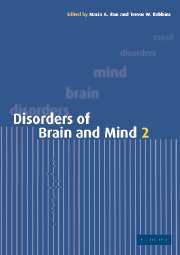Book contents
- Frontmatter
- Contents
- List of contributors
- Preface
- Part I Genes and behaviour
- Part II Brain development
- Part III New ways of imaging the brain
- Part VI Imaging the normal and abnormal mind
- 7 Functional neuro-imaging and models of normal brain function
- 8 Functional magnetic resonance imaging in psychiatry: where are we now and where are we going?
- 9 Positron emission tomography (PET) neurochemistry: where are we now and where are we going?
- Part V Consciousness and will
- Part IV Recent advances in dementia
- Part VII Affective illness
- Part VIII Aggression
- Part IX Drug use and abuse
- Index
- Plate section
- References
8 - Functional magnetic resonance imaging in psychiatry: where are we now and where are we going?
from Part VI - Imaging the normal and abnormal mind
Published online by Cambridge University Press: 19 January 2010
- Frontmatter
- Contents
- List of contributors
- Preface
- Part I Genes and behaviour
- Part II Brain development
- Part III New ways of imaging the brain
- Part VI Imaging the normal and abnormal mind
- 7 Functional neuro-imaging and models of normal brain function
- 8 Functional magnetic resonance imaging in psychiatry: where are we now and where are we going?
- 9 Positron emission tomography (PET) neurochemistry: where are we now and where are we going?
- Part V Consciousness and will
- Part IV Recent advances in dementia
- Part VII Affective illness
- Part VIII Aggression
- Part IX Drug use and abuse
- Index
- Plate section
- References
Summary
Introduction
As a technique for measuring changes in oxygenated cerebral blood flow related to local neuronal activity, functional magnetic resonance imaging (fMRI) is approximately 10 years old. As an instrument of psychiatric research, it is even younger – perhaps 7 years old by the time this book is published.
Already it is clear that fMRI has some outstanding technical advantages compared with previously available methods for functional neuro-imaging, such as positronand single photon-emission tomography (PET and SPET). (For a general introduction to fMRI physics, experimental design and data analysis, see review articles by Bullmore and Suckling (2000, 2001).) First and foremost, it is remarkably safe. There is no requirement for exposure to ionizing radiation or radioisotopes and, at static magnetic field strengths of 3 tesla or less, the only significant health and safety risks are posed by the loud acoustic noise of most scanners (subjects must wear ear-protectors) and by deposition of radiofrequency energy (which limits scanning time in a single session to 45 minutes in some centres). This degree of safety considerably relieves any ethical concerns about scanning patients and usefully favours study designs entailing multiple repeated measures on each subject. The second major advantage of fMRI is that it has superior spatial resolution (in the order of mm) and temporal resolution (in the order of s) compared with any single alternative modality for investigation of living human brain function.
- Type
- Chapter
- Information
- Disorders of Brain and Mind , pp. 171 - 180Publisher: Cambridge University PressPrint publication year: 2003



